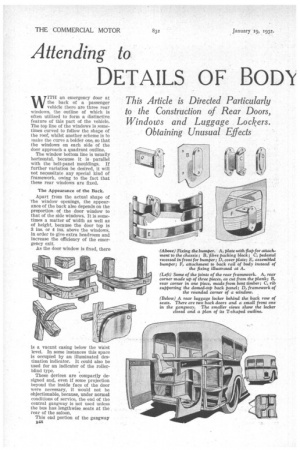Attending to
Page 66

Page 67

If you've noticed an error in this article please click here to report it so we can fix it.
DETAILS OF BUM
DESIGN
WITH an emergency door at the back of a passenger vehicle there are three rear windows, the outline of which is often utilized to form a distinctive feature of this part of the vehicle. The top line of the windows is sometimes curved to follow the shape of the roof, whilst another scheme is to make the curve a bolder one, so that the windows on each side of the door approach a quadrant outline.
The window bottom line is usually horizontal, because it is parallel with the belt-panel mouldings. If further variation be desired, it will not necessitate any special kind of framework, owing to the fact that these rear windows are fixed.
The Appearance of the Back.
Apart from the actual shape of 'the window openings, the appearance of the back also depends on the proportion of the door window to that of the side windows. It is sometimes a matter of width as well as of height, because the door top is 3 ins. or 4 ins, above the windows, in order to give extra headroom and increase the efficiency of the emergency exit.
As the door window is fixed, there is a vacant casing below the waist level. In some instances this space is occupied by an illuminated destination indicator. It could also be used for an indicator of the rollerblind type.
These devices are compactly designed and, even if some projection beyond the inside face of the door were necessary, it would not be objectionable, because, under normal conditions of service, the end of the central gangway is not used unless the bus has lengthwise seats at the rear of the saloon.
This end portion of the gangway B4A
might also be used to form part of a rear luggage locker. In order to make such a locker practicable, the coach should be long enough to make about 1 ft. available between the back of the Mk row of crosswise seats and the back of the coach.
The locker extends for the full width of the body behind these seats and its top is level with the tops of the seat backs. Moreover, it extends into the central gangway as far as the front of the cushions. Therefore, in plan, this locker is approximately T-shaped.
It has a pair of back doors, also a small door in the gangway, opening towards the front of the vehicle. As the locker is only waist-high, the rear windows are unobstructed, although it is possible that the top of the locker would often be used by the passengers for their parcels and hand luggage.
Fitting Rear Bumpers.
A necessary part of the rear equipment is a fender, or a pair of quadrant-shaped bumpers. The vehicle owner may, at first, decide to do without them, but after once having the rear panel dented, however
slightly, he does not, as a rule, require any urging to have them fitted.
The triple, or even quadruple, set of bars stretching for the full width of the vehicle gives the maximum amount of protection, but often the centre is required to be free from obstruction so as to afford access to the spare-wheel locker or cradle. Nevertheless, the continuous bar could be provided with a central hinged or detachable portion.
A bar bumper has flaps for attaching it to the side members of the chassis. When mounted, quadrantshaped bumpers have a space between them approximately equal to the width of the chassis, so it follows that, if they be attached to the chassis, the flap gives direct support from only one end.
An Alternative Arrangement.
As an alternative the bumper is attached to the back bar of the bottom framework of the body. There is then the opportunity for placing a support near the centre of the bumper.
The back of the double-decker has undergone many changes since the adoption of the covered upper saloon, soon followed by the enclosure of the staircase and, finally, with the introduction of front and central entrances, the complete enclosure of the back.
If the upper deck has a rear window made in the form of an emergency exit, it is, in appearance, similar to one with a pair of fixed windows, because there is a middle stile to give it rigidity.
When the emergency exit is elsewhere a single large rear window is often favoured. A single window for the back of the lower-deck platform enclosure provides an excellent outlook, especially when the staircase is straight void does not obstruct the window.
The attractiveness of the back of the vehicle is also dependent on the shape of its profile. The conventional design is a vertical line forming the continuation of the rear dome of the roof, whilst at the bottom of the body the line curves Inwards to the turn-under at the rear.
As the front of the vehicle has a sloping windscreen, the general design has more balance if the back slopes inwards towards the roof. This style of rear panelling is adopted both for single-deckers and double-deckers and the effect is decidedly pleasing.
Attention to Symmetry.
If appearance is to be closely studied the outline of the back, as viewed in plan, should not consist of a straight line joining the two arcs of the rear corners. Instead, the back panel should have its main portion curved throughout, thus preserving a symmetrical appearance.
The curve required is only slight, so that the body is about in. longer in the centre than it is where the back panel joins the rounded corner. This roundness of the back is sufficient to prevent the back from having the appearance of being




































































































